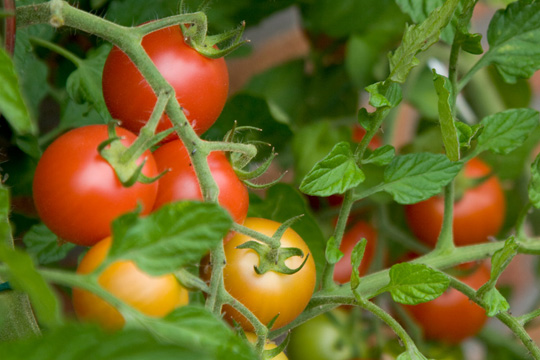
Reducing Food Waste in Foodservice
October 16, 2018 by Doreen Garelick, Dietetic Intern
Our intern Doreen attended a food waste summit for restaurants and compiled these tips to help food service operators redirect…
Nutrition 101
April 5, 2013

Dietetic Intern Lauren Marino shares her tips on how to eat as locally and seasonally as possible -- by growing your own produce!
Seasonality has a huge effect on produce as it can dramatically change the taste and quality of your food. Not only is local and seasonal produce fresher by default, but also it often contains a higher concentration of nutrients than when out of season. Growing your own produce can be easy, and you can’t get more local or more seasonal than growing it yourself!
Now that it’s officially spring, the warmer temperatures make growing your own fruits and vegetables easier. Whether you have a big yard in which to plant rows of fruits and vegetables or a small, sun-facing window sill, growing your own produce can be easy if you know how:
The best herbs to include in your window sill garden are chives, oregano, parsley and thyme. These herbs grow compact and will maximize the amount of space that you have available. They can be planted from seeds or small plants in pots and containers ranging from 4-6 inches deep for seeds and 6-12 inches deep for plants. Use a high-quality potting mix to minimize any risk of disease and add compost to the mix to provide the plants with more nutrients.
Your herbs will thrive with full sunlight from a south-facing window for 5-6 hours a day. Be careful to not overwater your herbs; letting water collect in the pots can ruin the plant. Yellowing herbs indicate over-watering. To promote further growth of the herbs, trim 2-3 inches off the tips once they start growing.
Soil is the most important part of any garden. When starting a backyard garden, it’s important to ensure the soil is moist, rich in compost and free of rocks and weeds. Tilling and turning the soil improves the soil structure so that roots can attach easily, water can drain quickly and air can pass through. Once the soil has been tilled and composted, build up the soil into raised rows to plant the root vegetables, tomatoes and peppers in. For other types of vegetables, use the 3-foot wide row method to grow the most produce in the least amount of space. This method also produces fewer weeds and less watering is necessary.
To save even more space, you may wish to plant vertically. Grow vegetables such as peas, cucumbers and squash on a trellis. Instead of sowing vegetables from seed, you can save time by purchasing seedlings from a nursery and then transplanting the vegetables and fruits into your own garden. This method works best for tomatoes, peppers and cucumbers. Always look for seedlings with strong, sturdy green leaves. Lastly, it is important to rotate your crops year after year. Planting crops from the same family in the same place in your garden every year allows them to build up disease and reduces the soil fertility.
Have you ever grown your own produce? Share your tips in the comment section below!

October 16, 2018 by Doreen Garelick, Dietetic Intern
Our intern Doreen attended a food waste summit for restaurants and compiled these tips to help food service operators redirect food waste from landfills.
Nutrition 101

Nutrition 101
September 26, 2018 by Doreen Garelick, Dietetic Intern
Ever notice headlines about rapid weightloss? Dietetic Intern Doreen Garelick looks deeper into a recent eye-catching headline to see if there's any truth behind it.
Connect
 Follow us on Twitter
Follow us on Twitter Friend us on Facebook
Friend us on Facebook Follow us on Pinterest
Follow us on Pinterest Follow us on Instagram
Follow us on Instagram Read our Blog
Read our Blog Watch videos on YouTube
Watch videos on YouTube Watch videos on Vimeo
Watch videos on Vimeo Connect with us on Linkedin
Connect with us on Linkedin Find us on Foursquare
Find us on Foursquare
Tweets by @SPEcertifiedBlog Search
Categories
SPE Certified Newsletter
Sign up for news on the latest SPE-certified venues, events and SPE updates.
We will never share your personal information with a third party.